Maxxis has a growing range of Wide Trail (WT) mountain bike tyres, including several options with the more robust DoubleDown casing. To make sense of the range, we gathered the Aggressor, Minion DHF, Minion DHR II and Shorty in their respective WT DoubleDown outfits, and gave them to our resident rubber-punisher, James Vincent, for a mini-shootout. Over to James!
Rims, fork stanchions, cassettes, axles, post-Christmas waistlines. You name it, it’s getting wider.
As rims have gotten wider though, tyre design needed to follow. Mount a ‘traditional’ 2.3in tyre (what used to be the go-to all mountain/hardcore trail/enduro tyre width) on a rim that has a 30mm internal width or wider, and the knobs are likely to end up in the wrong place. Those previously perfectly placed shoulder knobs can end up near the top of the casing, with the mohican-like profile leading to poor handling and decreased traction as the barren sidewalls are brought into contact with the ground. This is also known as: Not Good Times™.
What we’ve got here then is a quartet of what Maxxis has dubbed Wide Trail (WT) tyres – tyres designed specifically for new-school rims measuring 30-35mm wide internally. We’ve got an Aggressor 2.5 WT DoubleDown, a Minion DHF 2.5 WT DoubleDown, a DHR II 2.4 WT DoubleDown, and finally a Shorty 2.5 WT DoubleDown.
In short, these four enduro-capable tyres, and the various combinations they can provide, will cover pretty much any trail condition you’re likely to come across.
Just to clarify for those wondering – these are not Plus tyres – that denomination is reserved for 2.8in and up. Nor are they semi-plus (perhaps also known as ‘Plus-Minus’, or ‘British Plus’ as we prefer to call it), which covers the trendy 2.6in tyre width. While Plus tyres are brilliant for everyday trail riding, they’re not quite so aggressive as a narrower tyre. If you’re racing enduro events regularly, or you find yourself regularly hunting out the steep stuff in your local woods, then these 2.4-2.5in width tyres are the ticket.
The other common denominator between our four test tyres is that they’re all equipped with Maxxis’ reinforced DoubleDown casing. One step, erm, down from a downhill casing, a DoubleDown casing is on average 15% lighter than a 2-ply DH tyre with the same tread pattern, yet offers significant impact protection over an EXO casing.
A butyl insert at the bead provides this extra protection, right at the point where most sidewalls get damaged, while the tops of the sidewalls are left relatively unprotected to save a bit of weight. That’s not to say these a featherweight XC tyres though – each of these four tyres tips the scales at well over 1100g!
All four tyres were mounted to a variety of rims measuring 29-33mm wide internally, including a set of Hunt Enduro Wide wheels, some E*13 TRS hoops, and Spank Oozy 345’s. We also tested them on both hardtails and full suspension bikes, and over the six month test period they were ridden across a wide variety of conditions from the Lake District, to BikePark Wales, Whinlatter, the Ard Rock Enduro, Dyfi Bike Park, the Quantocks, and finally the Mendips.
So with the tough casing, and wide-rim specific profile, how have these tyres performed on the trail? And perhaps more importantly, which is the right one for you?
The Aggressor
Billed as an all rounder tyre for those riding at higher speeds in drier conditions on modern mountain bike trails, the Maxxis Aggressor has found favour amongst riders looking for something with a bit more traction out back than a full on semi slick would otherwise afford.
Previously only available as a 2.3in model, the tread pattern hasn’t changed much on this new 2.5in Wide Trail version – things have just been spread out a bit to compensate for the larger casing. It’s still a dual compound tyre, with a softer rubber compound on the shoulder knobs and a very hard compound in the centre for faster rolling.
Maxxis Aggressor 27.5×2.5 WT DoubleDown Specifications
- All-round tyre suited to hardpack and loose-over-hard trail surfaces, dry conditions
- Actual weight: 1142g
- Measured width 2.45in
- Rubber compound: Dual
- DoubleDown casing (120tpi)
- RRP £69.99
Overall: Unless it’s particularly sloppy, the Aggressor makes for a great, reasonably quick-rolling rear tyre. Despite the shallower tread profile, it actually has good braking and climbing traction, and the high volume DoubleDown casing allows you to run nice and low pressures for plenty of high-frequency grip. A tough and comfortable tyre that is more versatile than its slimmer 2.3in sibling. Read the full review here.
The Minion DHF
The venerable Minion DHF is one of those tyres that Maxxis got absolutely bang on, right at the very beginning. Since its introduction over a decade ago, the tread pattern has hardly changed, only being adapted slightly to fit different carcass widths. It’s also been copied a lot.
Originally designed to withstand the rigours of downhill racing in loose and muddy conditions, the DHF has since found favour across pretty much all genres of mountain biking, with the exception of XC racing where light-weight and fast rolling are preferred over all out grip and durability. The familiar tread pattern incorporates ramped centre knobs for lowered rolling resistance and aggressively siped side knobs to increase gripping edges, cornering traction and generally just keep you pointing in the right direction.
Maxxis Minion DHF 27.5×2.5 WT DoubleDown Tyre Specs
- Designed for rocky, loose and loose-over-hard trail surfaces, dry to wet conditions
- Actual weight: 1215g
- Measured width: 2.45in
- Rubber compound: 3C MaxxGrip
- DoubleDown casing (120tpi)
- RRP: £69.99
Overall: There’s a reason why the Minion DHF is one of the most copied tread patterns going – it’s one of the grippiest and best cornering tyres out there for charging hard on. Factor in the soft 3C MaxxGrip compound, and the low pressures you can get with the DoubleDown casing, and unless it’s particularly sloppy, or super steep and loose, you won’t be wishing for more traction. Read the full review here.
The Minion DHR II
Sequels are quite often tyred (sorry) extensions of great films, focussed more on extracting more money from the cinema going public, with few exceptions. Fortunately, the DHR II is no poor sequel. In fact, this one is actually a lot better than the original.
While the original DHR wasn’t particularly well received, the Minion DHR II is a completely different beast. It’s less rear specific than before, and many riders I know have taken to running the DHR II up front as well as out back. The shoulder knobs have been nicked from the DHF, while the centre knobs are heavily siped for extra hold and braking traction in the loose stuff.
Maxxis Minion DHR II 27.5×2.4 WT DoubleDown Tyre Specs
- Designed for rocky, loose and loose-over-hard trail surfaces, dry to wet conditions
- Actual weight: 1135g
- Measured width: 2.4in
- Rubber compound: 3C MaxxTerra
- DoubleDown casing (120tpi)
- RRP: £69.99
Overall: Though the Minion DHR II gives you all the traction you would ever need out back, it performs equally well up front. The aggressive tread pattern delivers supremely controlled cornering grip and incredible braking traction, which really comes into its own the steeper and rougher the trail surface. It isn’t a quick tyre, nor is it the best in proper gloopy mud, but it is highly dependable across a wide range of conditions. Read the full review here.
The Shorty
The original Maxxis Shorty was released to great acclaim back in 2014, as a rather specific mud and wet weather tyre. Relatively narrow at 2.3in wide, it worked brilliantly when conditions suited it, but those same tall and soft knobs that made it so great in the wet, made it vague and squirmy in the dry and on harder surfaces. Yes, there was a 2.5in DH version, but that weighed an absolute ton, and as a result wasn’t particularly suited to non-uplifted riding.
Fortunately, Maxxis has tweaked the design somewhat, and this new 2.5 Wide Trail Double Down Shorty promises to take everything that made the original tyre so great, and make it better.
Maxxis Shorty 27.5×2.5 WT DoubleDown Tyre Specs
- Designed for loose powder, rocks, loam and muddy surfaces, damp to wet conditions
- Actual weight: 1150g
- Measured width 2.4in
- Rubber compound: 3C MaxxGrip
- DoubleDown casing (120tpi)
- RRP: £69.99
Overall: Certainly not a tyre for those who are looking for speedy rolling or maximum mileage. Instead, the Shorty places all its eggs into the traction basket and delivers an incredibly sticky tyre that I honestly struggled to find the limits of. The 3C DoubleDown version isn’t cheap, but if you want wet weather confidence along with year-round versatility, you’re unlikely to find a grippier tyre than this. Read the full review here.
The Verdict
From dry and dusty to loose and wet, right up to where a full on mud spike is called for, these four tyres from Maxxis have got pretty much every possible hardcore riding condition covered. They are at the premium end of the scale, but that is reflected in the technology they manage to pack in and consequently their all round brilliant performance.
One piece of wisdom I can pass on to you; don’t be tempted to try and fit these tyres onto narrower rims. In the interests of completeness, I tried to shoehorn all of the tyres onto a Mavic XA Pro carbon wheel (internal width of 26mm), and after half an hour of struggling with washing up liquid, snapping numerous tyre levers and making my fingers so sore I could barely feel them, I had to admit defeat and give up. On the wide rims Maxxis has designed the WT tyres for, fitting isn’t an issue. But on narrower rims? Forget it and thank me later.
Is DoubleDown Worth The Pennies?
Yes, it’s a heavy and costly (roughly £20) addition to each tyre – there really is no getting away from that. But if you regularly ride on rough, rocky terrain, or you’re racing enduros where a puncture could cost you a race win, then that weight/cost penalty is massively outweighed by the benefits.
In the last six months, I’ve only managed to puncture one of the tyres, and that was during Ard Rock Enduro when I drifted off course and rode full speed into a dry stone wall. No tyre would have withstood the impact of that crash, and my ankle is still recovering. Whether you need DoubleDown at both ends however, is another question. In the past, I have had the occasional freak front puncture, but those were usually a combination of worse than normal line choice and lower pressures. Personally, I think the DoubleDown casing is most valuable on the rear, and I could get away with a lighter EXO casing up front. I’m also very keen to try out Maxxis’ new EXO+ casing that sits just below DoubleDown in the protection rating.
Decisions, Decisions
The Maxxis Shorty 2.5in WT DD excelled itself in a much wider range of conditions than I ever expected. Although it’s designed to work when things are loose and wet, I started riding it at the beginning of the best summer we’ve had in a long time and it didn’t see water for months. In spite of this, it was quite frankly, brilliant. It cornered well, braked well, and the tall, widely spaced knobs weren’t as squirmy as you might think. The only thing that would stop me from running one all year round, is that because the rubber is so soft, it wears exceptionally quickly. And at nearly £70 per tyre, that hurts!
The Maxxis Minion DHF 2.5 WT DD is a well-loved tyre for many good reasons. It’s ideal for loose rocky stuff and hard packed conditions, and I think you’d be hard pressed to find a better tyre for trail centre black runs. For the type of riding I do though, I prefer the feel of the DHR II on the front with its increased braking traction when things get really steep and loose.
The Maxxis Minion DHR II 2.4 WT DD is the true all rounder here – it’s a great rear tyre for when you need maximum traction, and it’s a fantastic front tyre when the going gets steep and loose. It’s slightly slower rolling than the DHF though, so if your home trails aren’t quite as rowdy as the northern Lakes, you might get on better with the DHF. It also has a relatively soft compound for a rear tyre too, so it’s wearing out pretty quickly.
The Maxxis Aggressor 2.5 WT DD is my pick for a rear tyre – it has nearly as much climbing and braking traction as the DHR II, but lasts so much longer – I’ve been running one for nearly six months and the knobs are looking nearly as good as new. Meanwhile, the DHR II is showing obvious signs of wear, for what are minimal gains. I’ve also not found the Aggressor lacking when cornering, even on wet grass, with a nice smooth transition from the centre knobs to the shoulder of the tyre, and the generous casing smoothes out small chatter bumps nicely.
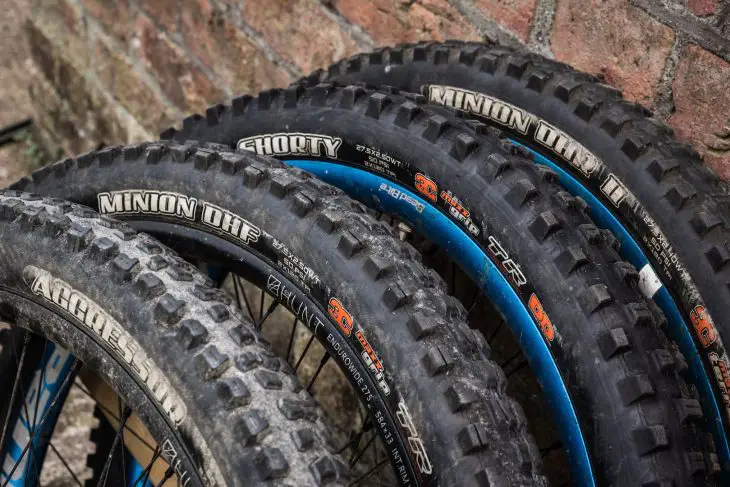
So Which Tyres Would James Ride?
In the dry dusty summer months, I would go with a Minion DHR II front, Aggressor rear combo. Great grip when it gets steep and technical, but still relatively fast rolling.
Once the weather starts turning in autumn and a bit more grip was needed, I’d think about replacing the Minion DHR II with the Shorty up front. The Shorty would easily make up any braking shortfall the Aggressor was lacking, and you’d still get the benefit of a fast rolling rear tyre that didn’t sap too much energy.
Finally, once things had turned really sloppy in winter, I’d take the Aggressor off the back and put the DHR II on in its place giving me maximum braking control and traction all round.
Review Info
| Brand: | Maxxis |
| Product: | Aggressor, Minion DHF, Minion DHR II, Shorty (all Wide Trail, DoubleDown casings) |
| From: | Maxxis, maxxis.co.uk |
| Price: | £69.99 each |
| Tested: | by James Vincent for 6 months |
Comments (4)
Leave Reply
Post Comment
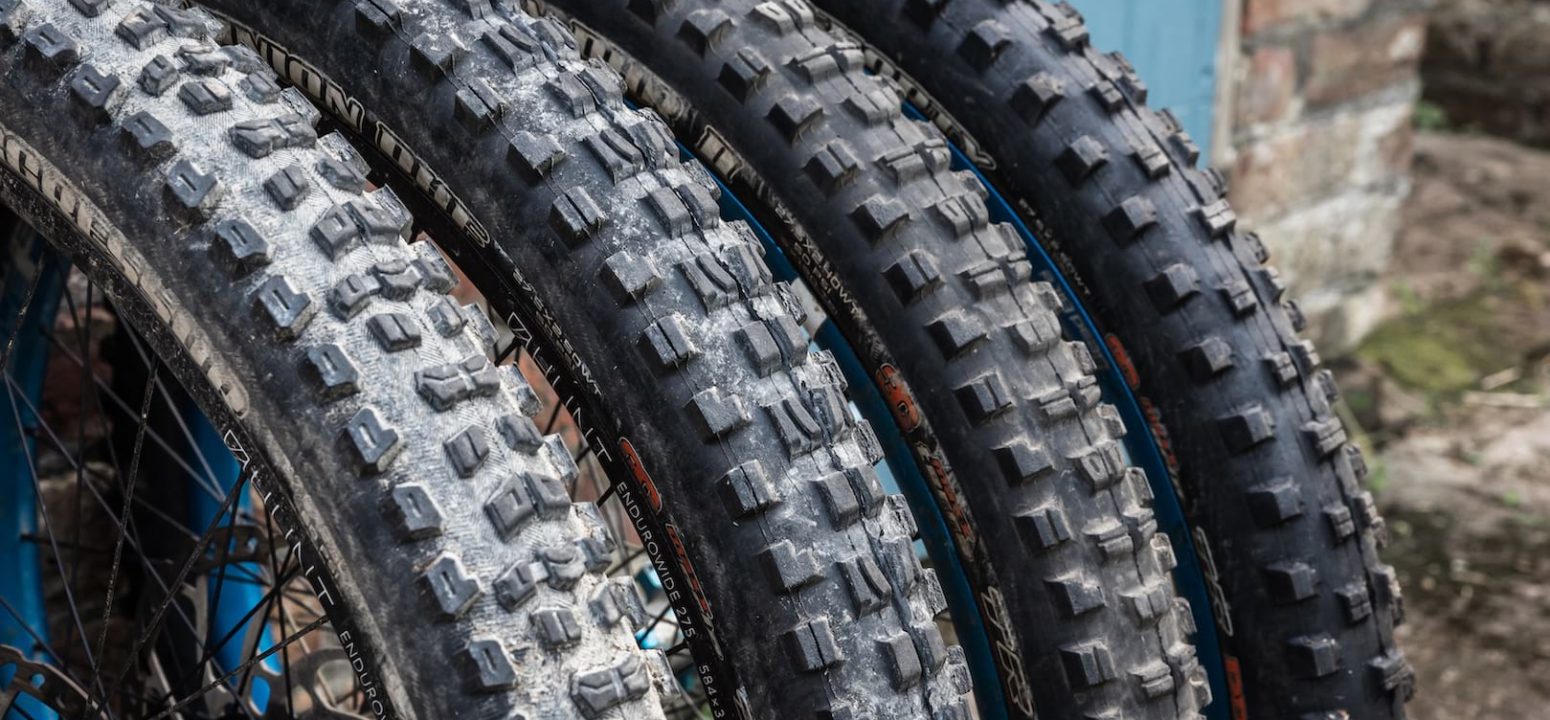
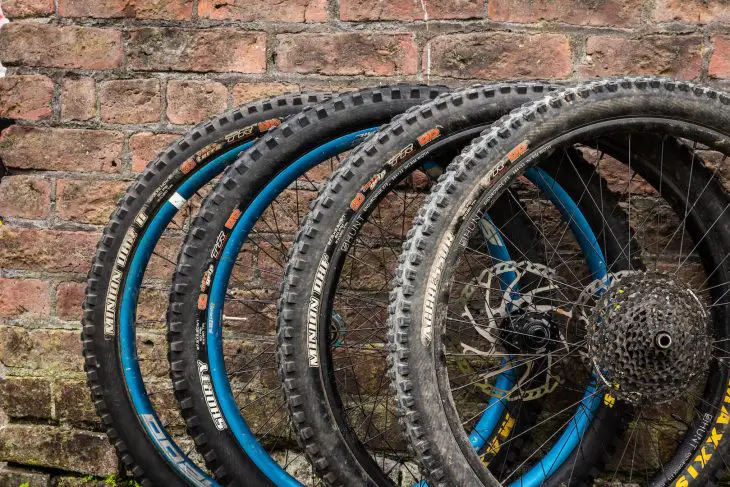
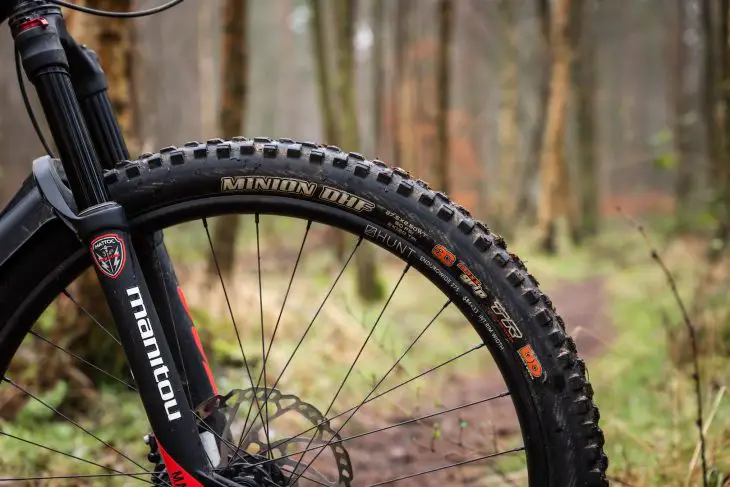
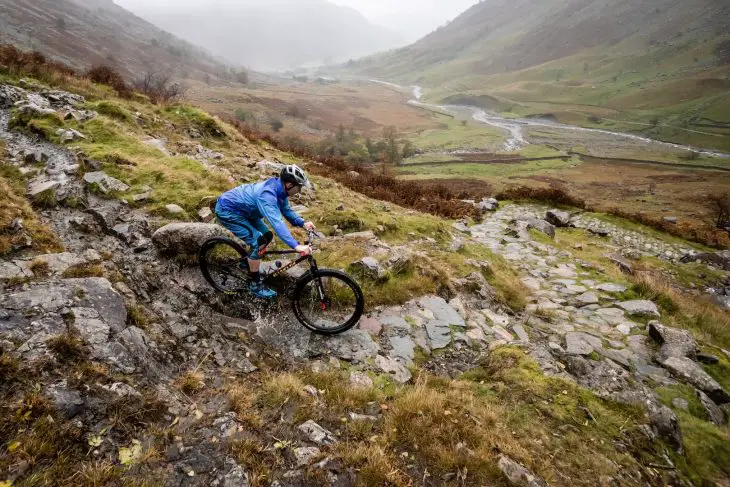
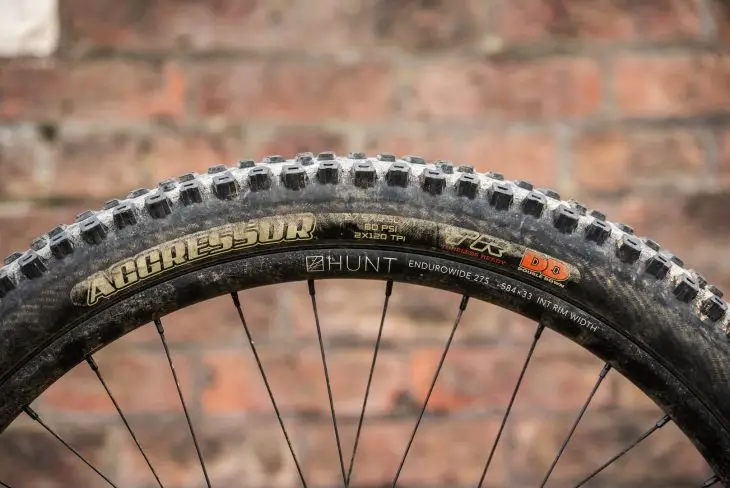
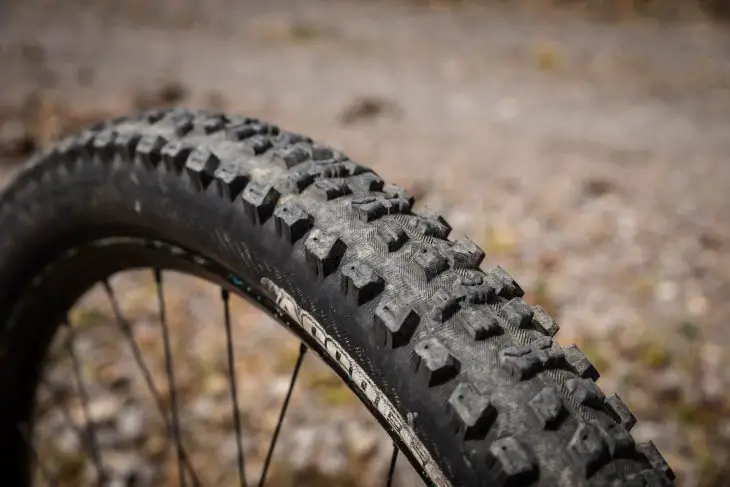
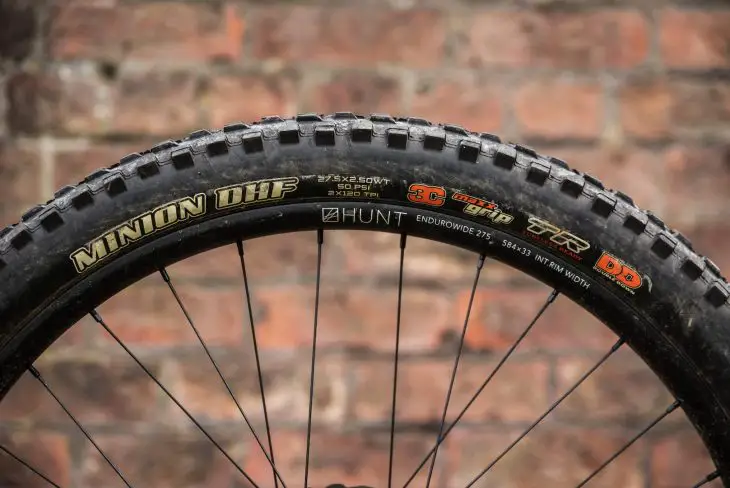
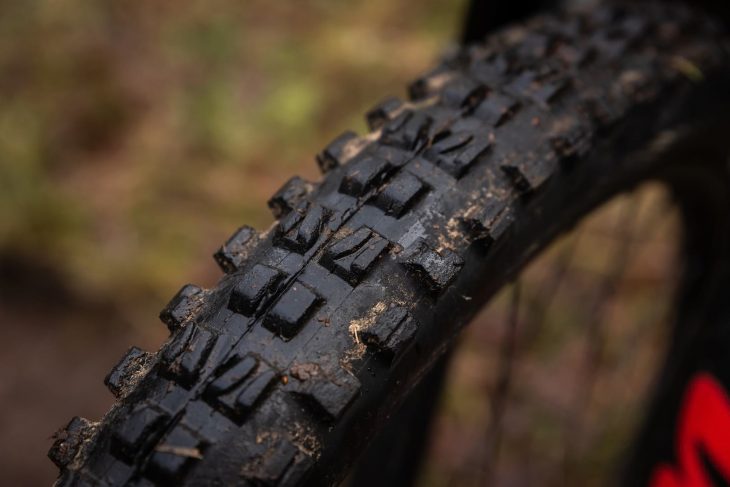
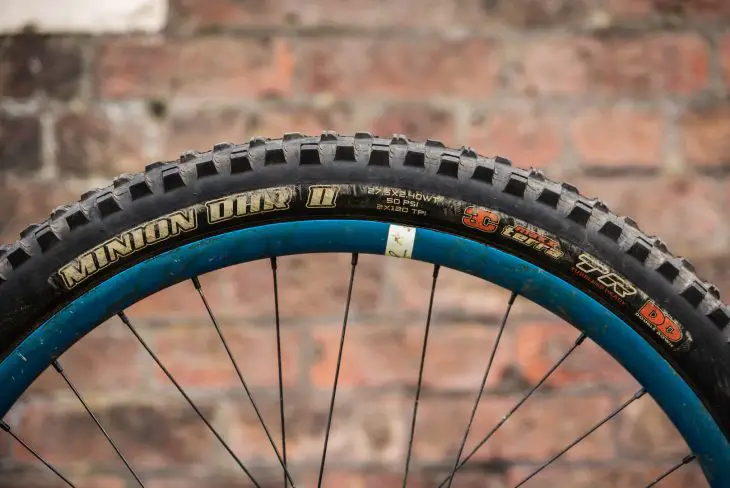
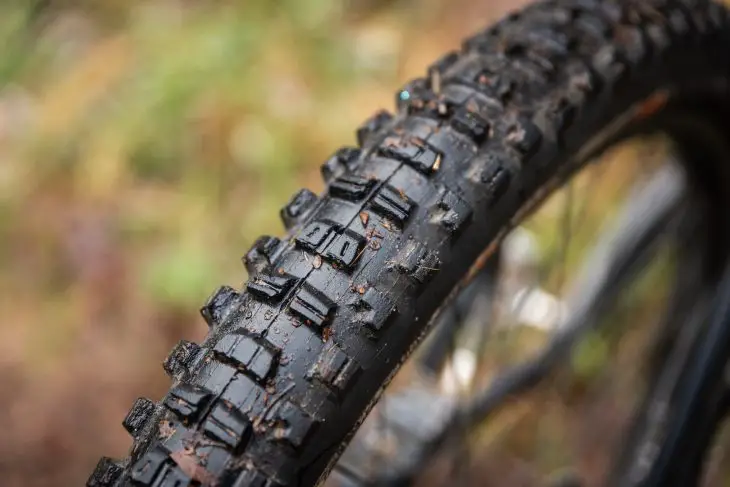
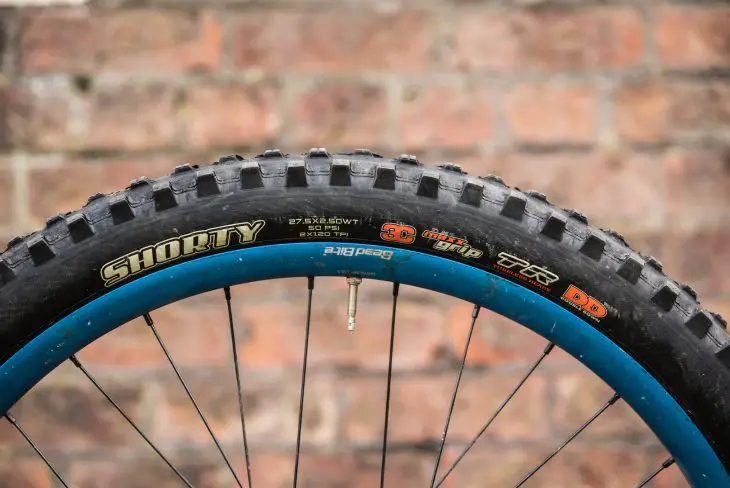
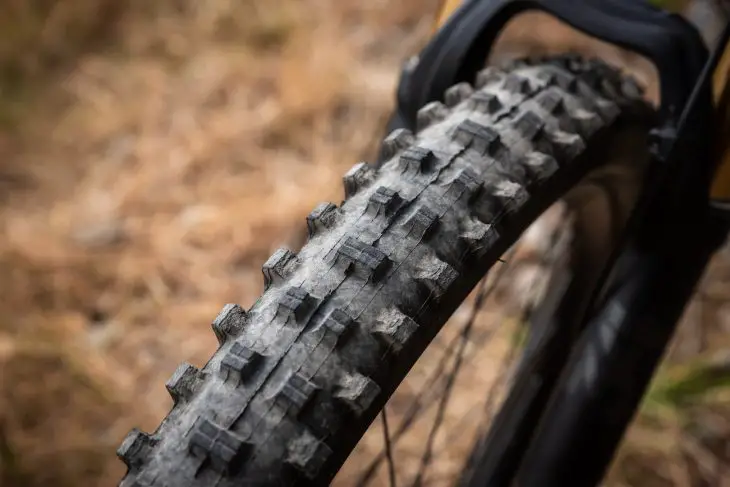
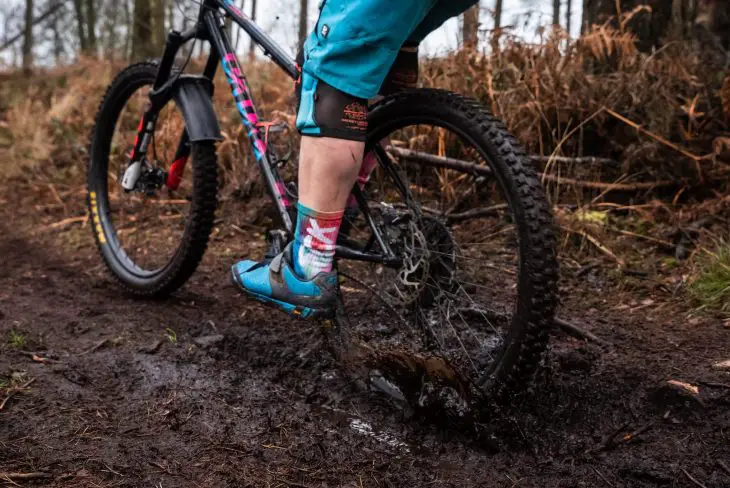
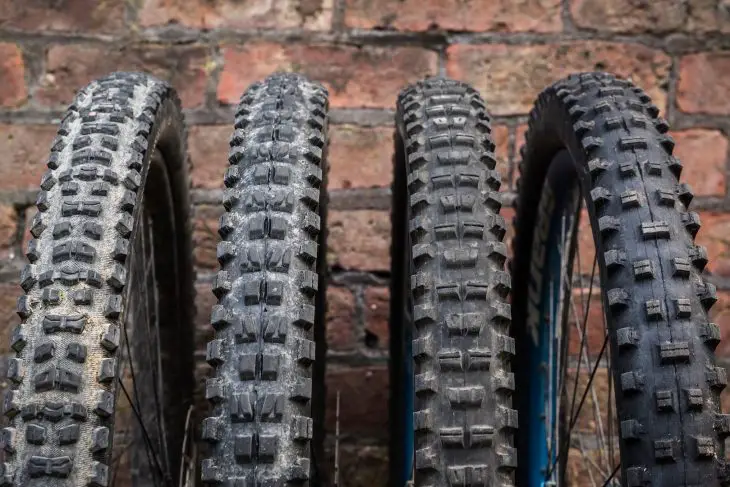
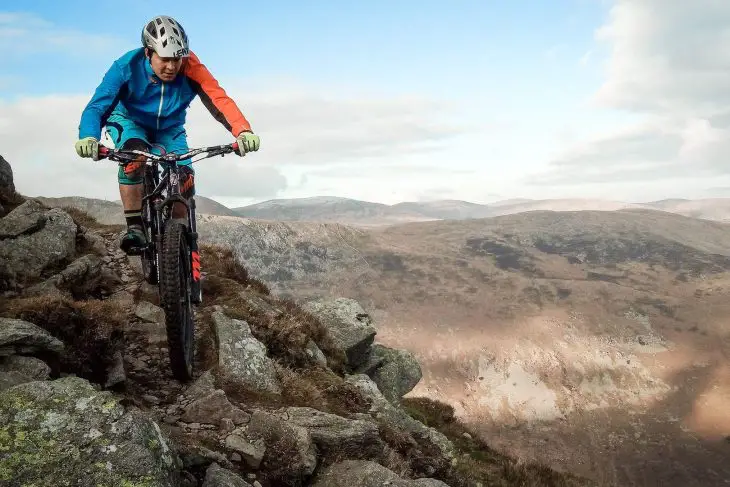
I would also add that the Shorty looks the absolute boss , very confidence inspiring!
Is DHF rear and DHR II from still a respected combo? I have a DHF 2.3 I could move out back if so…
Also, where’s the High Roller?? Seems an obvious one to include in this B2B!
@howsyourdad1 – 100% agree with you on that one!
@d4ddydo666 – For sure, and like James, I prefer the DHR II as a front tyre over the DHF. In fact, I just swapped tyres around on a Giant Trance 29er test bike, putting the DHF on the rear and the DHR II on the front. Very good combo with shit-tonnes of grip for a very broad range of conditions. Recommended!
The High Roller II didn’t make it into this test, as Maxxis UK don’t stock it in the Wide Trail/DoubleDown combo. Maxxis tyres can be a bit like that – there are so many variants, but certain markets only stock certain models.
[ST Wil]
DHF 2.5 up front every day on hardpack, the width and massive bag on it make for an outrageously stable, well damped front end. The DHRII doesnt have the same volume or speed to it…wheras the Shorty is just an unfair advantage on anything with a loose surface. EXO F and DD rear